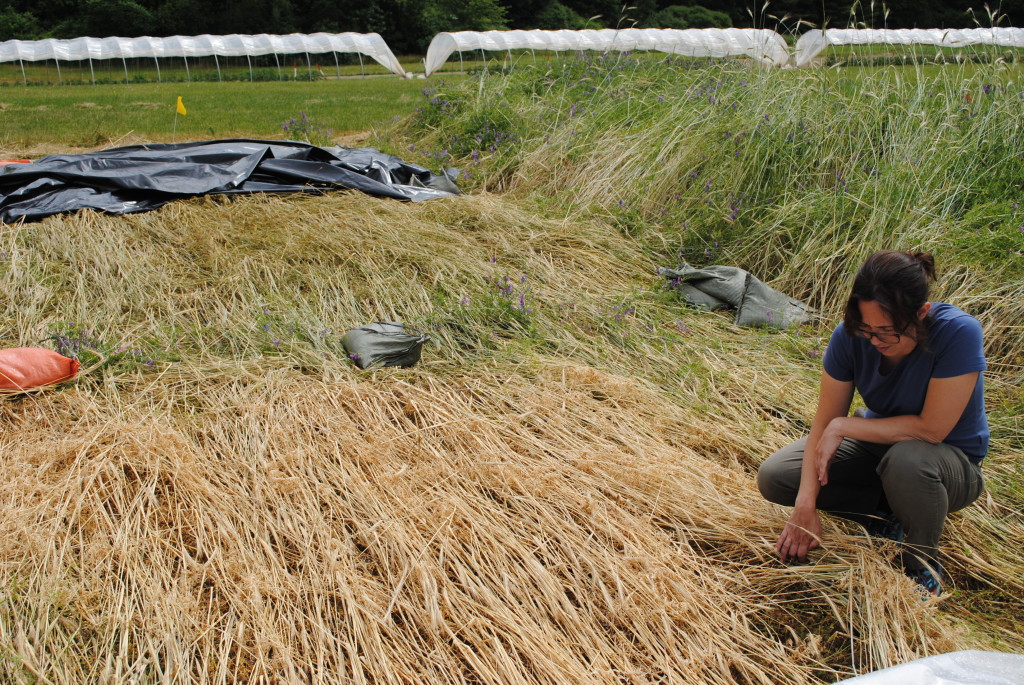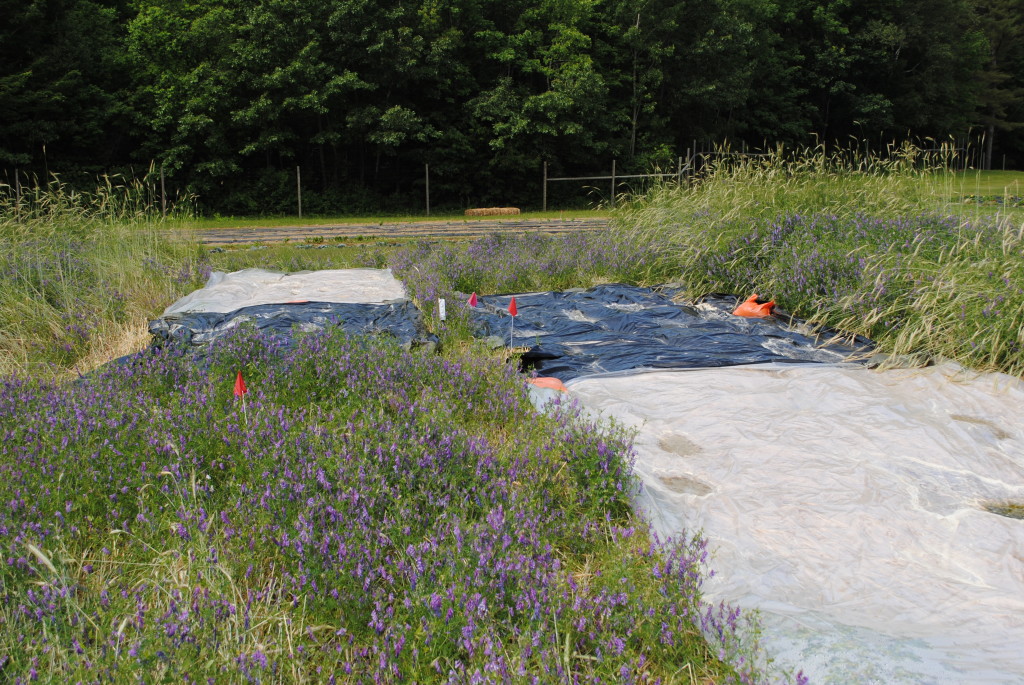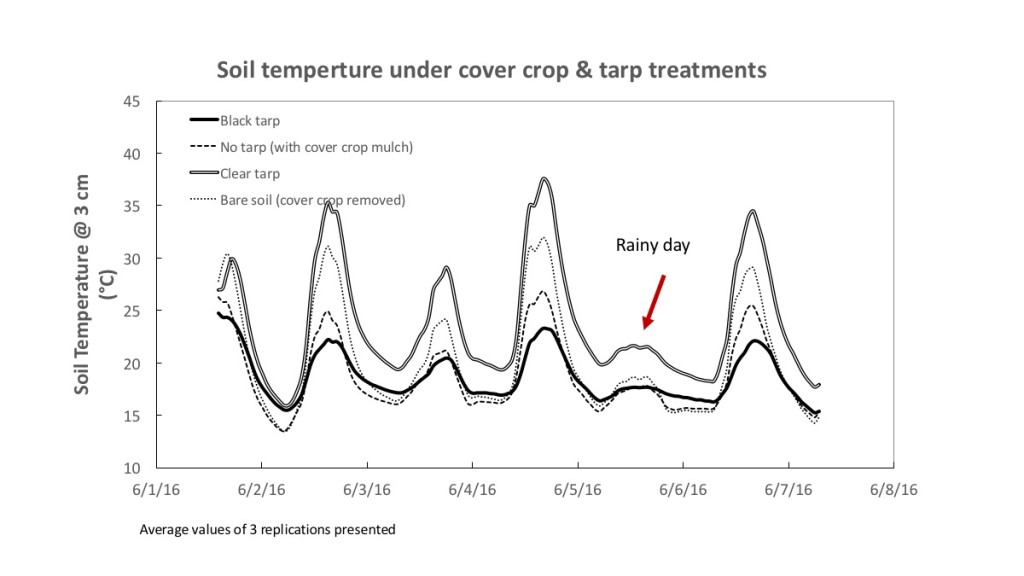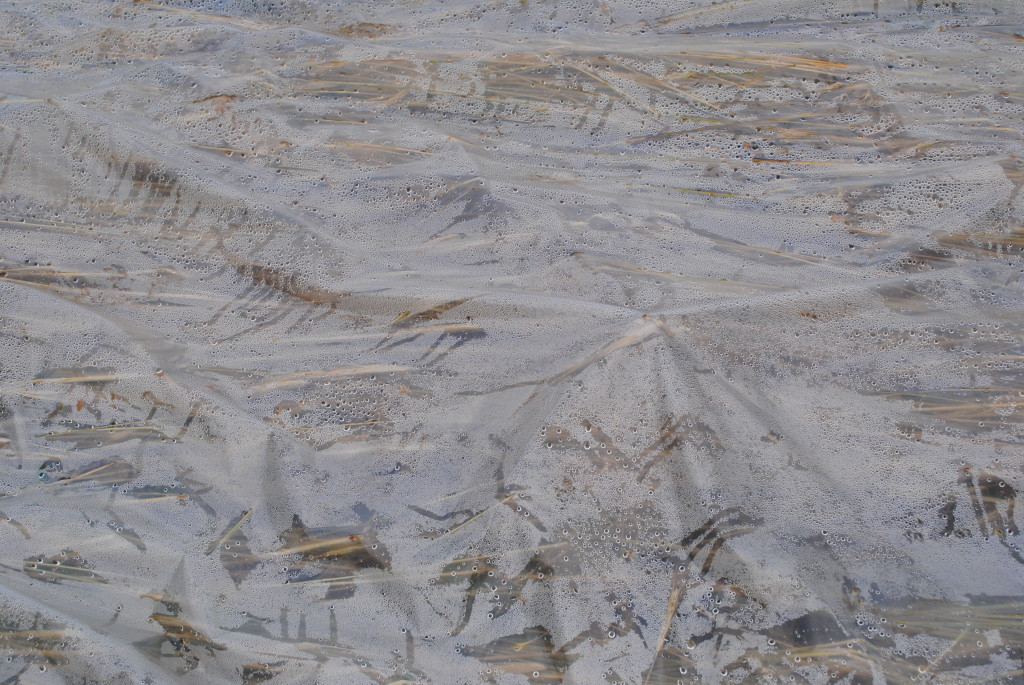UPDATE 8/24/16: Please see follow-up post on this experiment.
Initially, the title of this post was “The answer is clear: solarization is outperforming occultation for killing cover crops.” At the time I originally wrote it, clear tarps were killing cover crops so fast it was amazing. However, things change. In the end, the black tarps ended up suppressing weeds better than clear. Please read the follow-up post for the full story.
—————————–
I’ve got some data and I’ve got some pictures. Both are really interesting. If you missed the first post on this project, check it out here. So far, clear tarps appear to be killing cover crops and weeds quickly and effectively- more effectively than black tarps.

Carolyn checks out the difference between clear plastic (bottom) and black plastic (top) after two weeks of the tarp treatments.

Seamus overseeing his crimped and tarped masterpiece.
A quick re-cap. Seamus, eager undergraduate researcher and able farm hand in the Agroecology Lab here at the University of New Hampshire, wanted to look at no-till transplanted cabbage into a rye-vetch mulch. He had access to a roller-crimper, but we had a feeling that just rolling-crimping would create two problems: it might be hard to kill both the rye and the vetch at the same time, and we wouldn’t have enough biomass to create a long-lasting weed suppressive mulch. We don’t have biomass data yet, but while this cover crop performed nicely, it didn’t have the super high biomass as is required to create a really thick, weed-suppressive mulch.
To address the anticipated problems of not completely killing the cover crop and having weeds present, we wanted to look at different tarp types and durations of tarp treatment. We therefore ended up with three “tarp” treatments: black tarp (“occultation”), clear tarp* (“solarization”), and no tarp. Three different crimp/tarp application dates were: June 1, June 8, and today (!) June 22. We’ll transplant cabbage in two weeks.
It might seem a little incongruous to be using a 10′ roller crimper (not something small-scale growers generally have) and tarps (not something a large-scale growers would probably mess with), but crimping could easily be replaced with mowing for small-scale production.

Treatments were: black tarp, clear tarp, and no tarp. All were crimped with a roller-crimper prior to tarp application. Three weeks after the first crimp date, the vetch in the no-tarp treatment is coming back strong.
When we peeled back the tarps, the difference between black and clear was startling.

A lot of the difference between these treatments is likely because of temperature; the temperature differences at 3 cm (just over an inch deep) in the soil are big. The first week of data show incredibly clear trends toward higher daytime temperatures under the clear tarps. It is also notable that the soil under the black plastic was cooler than under the mulch alone or bare soil. This may seem counterintuitive because we all know that farmers use black plastic in plasticulture systems to warm the soil, but that system relies on good soil-plastic contact. The cooler temperatures under the black plastic in our case are likely because of poor soil-plastic contact– all that cover crop biomass in between limits heat transfer.

Since people from Canada have been contacting me about using tarps, I’m going to leave the degrees as Celsius unless Americans start complaining.
One of the reasons behind the high temperatures in the clear plastic is the condensation that forms. The folks at Penn State (on using plastic mulches) explain it concisely:
The under surface of clear plastic mulch usually is covered with condensed water droplets. This water is transparent to incoming shortwave radiation but is opaque to outgoing longwave infrared radiation, so much of the heat lost to the atmosphere from a bare soil by infrared radiation is retained by clear plastic mulch.

The almost instant condensation is one of the first things we noticed with the clear plastic. This helps retain heat.
We will keep you updated as the experiment progresses. In the mean time, the University of California has some great information on solarization and which weeds are generally killed by solarizing (this is on bare soil, though- we’re not sure anyone has looked at it for use with thick cover crops). They discuss some examples of when black plastic may be preferable to clear plastic as well.
More later, and please keep the questions and comments coming.
*We are using new plastic for both treatments. We recognize that most growers will want to use old greenhouse plastic and for the very reasons that it was retired from greenhouse service, it might not perform quite as well as new plastic. This is a research topic for someone else or for another season.
Partial funding for this project is being provided by the New Hampshire Agricultural Experiment Station.




Pingback: Clear Plastic vs. Black Plastic for ROASTING Grass/Weeds - The Survival Gardener